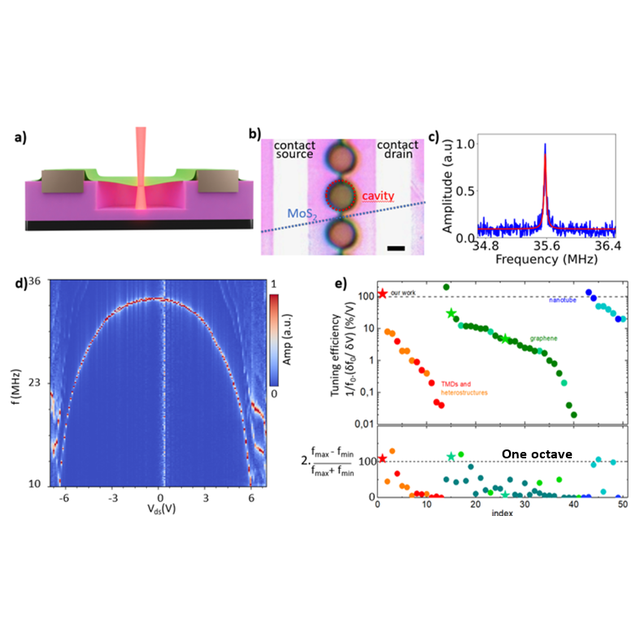The frequency of a musical instrument, such as a guitar string, is tunable over more than one octave, i.e. a ratio of two between the maximum and minimum frequency. It is defined as f=(k/m)^0.5 where k is the spring constant and m the mass of the resonator. To be successfully integrated into devices or sensors, the resonator frequency must be tuned. When the dimensions are reduced to nanometer sizes, such precise tuning is difficult to achieve in-situ. There is therefore a demand for simple and robust techniques to tune mechanical resonances at the nanoscale, and for nanoresonators that can be tuned over a wide frequency window. Among different nanoresonators, carbon nanotubes and two-dimensional (2D) materials have shown the best performance for mechanical frequency tuning, Here we design a thermally tuned nanomechanical resonator, using Joule heating and a very low electrical voltage, which lies at the interface between thermal transport in 2D materials and nanomechanics, with a focus on electrothermal actuation of mechanical vibrations and their frequency tuning.
The mat2D group at C2N is expert in the electronic properties of 2D materials (Graphene, MX and MX2) Our activities focus on the design, manufacture and electronic properties of new hybrid heterostructures based on two-dimensional materials, with a view to the realization of a new generation of nanoelectronic devices. This publication is produced in collaboration with the University of Pennsylvania.
References
Extreme mechanical tunability in suspended MoS2 resonator controlled by Joule heating
Anis Chiout1, Cléophanie Brochard-Richard1, Laetitia Marty2, Nedjma Bendiab2, Meng-Qiang Zhao3,4, A. T. Charlie Johnson3, Fabrice Oehler1, Abdelkarim Ouerghi1 & Julien Chaste1
npj 2D Materials and Applications volume 7, Article number: 20 (2023)
DOI : https://doi.org/10.1038/s41699-023-00383-3
Affiliations
1 Centre de Nanosciences et de Nanotechnologies - C2N, CNRS, Université Paris-Saclay, 91120, Palaiseau, France
2 Institut NÉEL, Univ. Grenoble Alpes, CNRS, Grenoble INP, F-38000, Grenoble, France
3 Department of Physics and Astronomy, University of Pennsylvania, 209S 33rd Street, Philadelphia, PA, 19104 6396, USA
4 Otto H. York Department of Chemical and Materials Engineering, New Jersey Institute of Technology, Newark, NJ 07102, USA
Figure : A suspended MoS2 nanoguitar. (a) Schematic of the suspended MoS2 membrane in a back-gated transistor configuration, laterally contacted by two gold electrodes (b) Optical microscopy image of the sample. The scale bar is 2µm (c) Mechanical response of the membrane near 35.6 MHz, as measured by our optical technique. (a) Variation of the frequency as a function of the heating voltage Vds. It shows a huge tunability of the frequency from 34 to 10 MHz. (b) Efficiency and amplitude values of our frequency variation for our work and other references on TMDs and 2D heterostructures.









